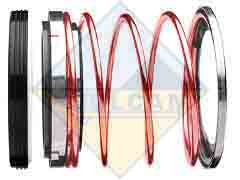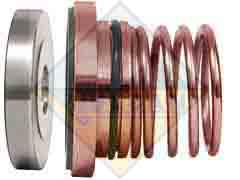ようこそバルカンへ
Welcome to Vulcan's Unique Seal Identification (ID) Suite providing you, the user, a view of our complete range of seals, with the capability to identify seals and their characteristics as well as conversions from our competitor product codes.
ようこそバルカンへ
| Conical Spring Seal | |
|---|---|
 |
The Coil on these seals has a conical shape. In most cases the end of the coil is an interference fit on the shaft, and drives the rotary. |
| Elastomer Bellows Seal | |
|---|---|
 |
The Primary part of this seal is the elastomer bellows that seals and drives the seal. Usually the elastomer bellows and the energising parallel coil are approximately the same length. |
| Parallel Spring Seal | |
|---|---|
 |
The coil on these seals is parallel to the shaft. The seal is driven from the seal head. |
| Multiple Coils Seal | |
|---|---|
 |
These seals are energised by multiple small coils. |
| Wave Spring Seal | |
|---|---|
 |
These seals are energised by sinusoidal wave springs. |
| Metal Can Seal | |
|---|---|
 |
The primary characteristic of these seals is the pressed steel 'can' around the elastomer seals. |
| Rubber Encased Seal | |
|---|---|
 |
These seals are almost entirely encased in rubber |
| Face Kit | |
|---|---|
 |
Sealing faces supplied on their own or with springs and/or 'o' rings. |
| Flygt® Seal | |
|---|---|
 |
Upper or Lower Seal for Flygt® Pumps. Our design is far simpler and much superior to the originals, and therefore does not resemble them |
| Sprung Stationary Seal | |
|---|---|
 |
These are seals where the spring-energised section is the stationary section |
| Collet | |
|---|---|
 |
These are the outer 'sleeves' of sealing arrangements. |
| Stationary Only | |
|---|---|
 |
These are stationary parts only, often called seats or stats. |
| Contherm® Drier sealing part | |
|---|---|
 |
A component of the Alfa Laval Contherm ® Drier seal system |
| Steel ring with grub screws | |
|---|---|
 |
Steel ring to fix working length, clamps to shaft with grub screws. |
| Carbon Bush | |
|---|---|
 |
Solid Carbon bush, to hold the shaft correctly in place in seal assemblies. Not a lapped seal part. |
